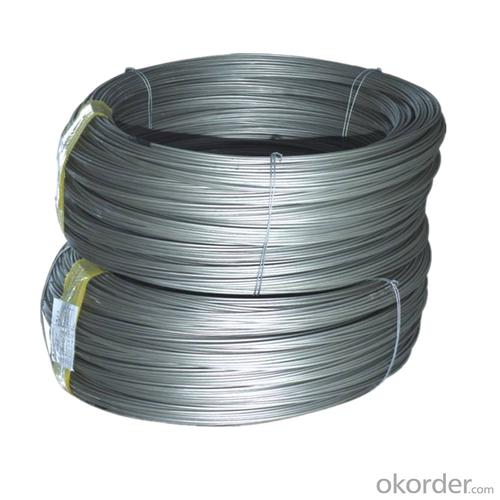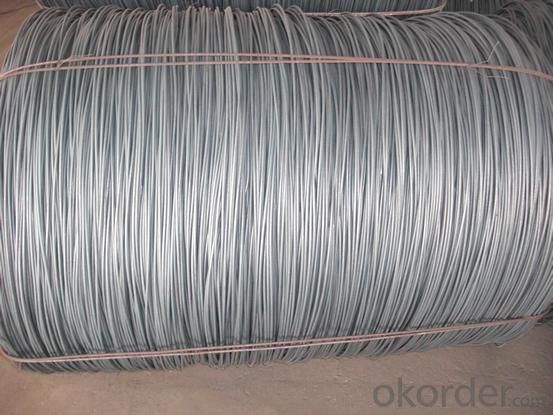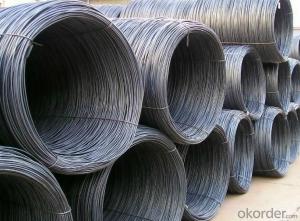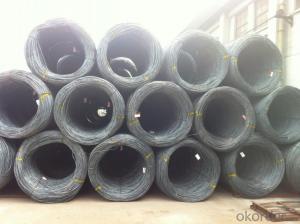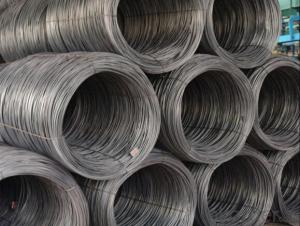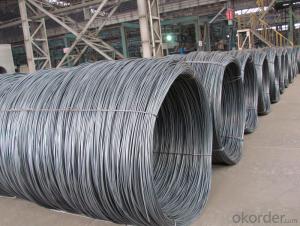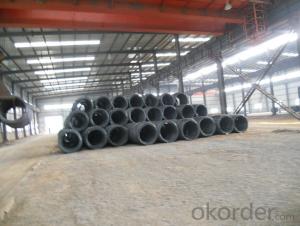Hot Rolled Steel Wire Rods in Coils SAE1008B
- Loading Port:
- Tianjin
- Payment Terms:
- TT OR LC
- Min Order Qty:
- 1000 m.t.
- Supply Capability:
- 1000000 m.t./month
OKorder Service Pledge
OKorder Financial Service
You Might Also Like
Specification
1. Introduction:
.commodity:steel wire rod
.grade:Q195,SAE1008B-SAE1018B
.diameter:5.5mm-14mm
.type:in coil
.coil weight:around 2 mt
2. Specifications:
wire rope can be drawn from Φ5.5mm-Φ12.00mm.
Annealing heat treatment and Phosphating are availiable as customer's requirement.
Productsteel wire rope
StandardAISI, ASTM, BS, DIN, GB, JIS
Material/steel gradeQ195-Q235,SAE1006B, SAE1008B, SAE1010B, SAE1018B, or according to customers requirements
Wire Gauge5.5-12mm
Coil weight1.8-2.1mts
MOQ25MT
Delivery Time15-30 days after receipt of L/C or deposit by T/T
PackingIn coil and load in container, if large quantity, by bulk vessel; Can be packed as customers' special requirements
Payment terms1).100% irrevocable L/C at sight.
2).30% T/T prepaid and the balance against the copy of B/L.
3).30% T/T prepaid and the balance against L/C
3.Application:
Applicationwidely used in machinery parts, manufacturing industry, electronics industry, metal tools and others
4. Pictures
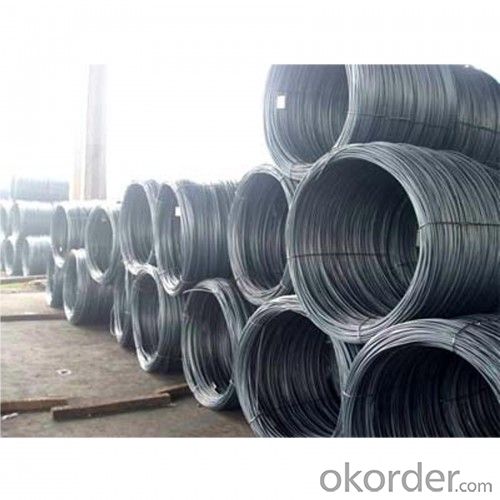
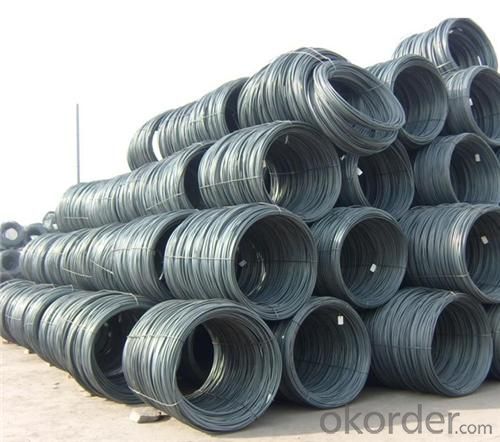
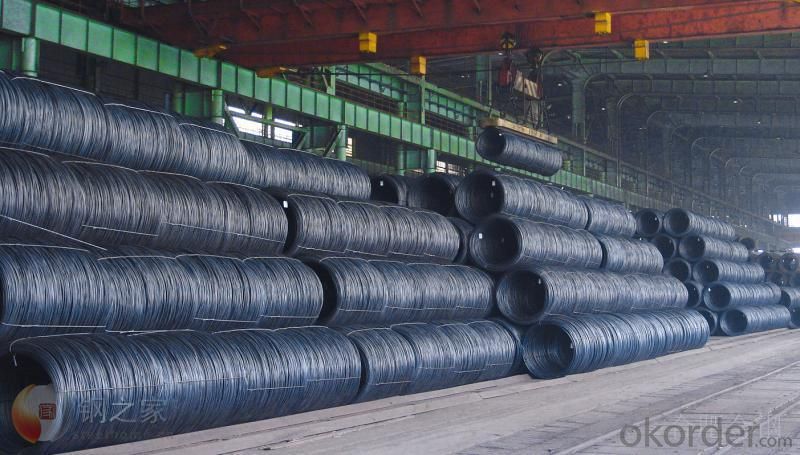
5.FAQ
We have organized several common questions for our clients,may help you sincerely:
①How about your company?
A world class manufacturer & supplier of castings forging in carbon steel and alloy steel,is one of the large-scale professional investment casting production bases in China,consisting of both casting foundry forging and machining factory. Annually more than 8000 tons Precision casting and forging parts are exported to markets in Europe,America and Japan. OEM casting and forging service available according to customer’s requirement.
②How to guarantee the quality of the products?
We have established the international advanced quality management system,every link from raw material to final product we have strict quality test;
- Q: How is steel wire rod used in the automotive industry?
- Steel wire rod is commonly used in the automotive industry for various applications. It is primarily utilized in the production of automotive components such as springs, cables, and tires. The high strength and durability of steel wire rod make it ideal for reinforcing parts that require resilience and resistance to wear and tear. Additionally, steel wire rod is also used in the manufacturing of safety belts, which rely on its tensile strength to provide security to passengers.
- Q: How is steel wire rod used in the production of wire for automotive seat springs?
- Steel wire rod is used in the production of wire for automotive seat springs by being processed through various mechanical and heat treatments to enhance its strength and flexibility. This wire rod is then drawn into thinner wire strands that are coiled and formed into the spring shapes required for automotive seat applications. The high tensile strength of steel wire rod ensures that the seat springs can withstand the weight and pressure exerted on them, providing durability and comfort to the users.
- Q: How is steel wire rod used in the manufacturing of wire for electrical circuitry?
- Steel wire rod is used in the manufacturing of wire for electrical circuitry as it serves as the primary material for wire production. The wire rod is first processed through various steps like cleaning, annealing, and drawing to attain the required diameter and conductivity. These wire rods are then further processed and coated with insulating materials to create insulated wires, which are essential for electrical circuitry applications.
- Q: How is steel wire rod inspected for surface defects?
- The process of inspecting steel wire rods for surface defects involves two main methods: visual inspection and non-destructive testing. Trained personnel carry out the visual inspection, carefully examining the surface of the wire rod for any visible defects such as scratches, cracks, pits, or deformations. To ensure a thorough detection, proper lighting and magnifying tools are used. In addition to visual inspection, non-destructive testing techniques are used to further assess the quality of the wire rod. One commonly used method is magnetic particle inspection, where the wire rod is magnetized and a magnetic particle solution is applied on its surface. If there are any surface defects like cracks or discontinuities, the magnetic particles will cluster together, making the defect visible. Another method employed is ultrasonic testing, which involves transmitting high-frequency sound waves through the wire rod. Any internal or external defects will reflect these waves back, enabling the inspector to detect and measure the size and depth of the defects. Furthermore, eddy current testing is another non-destructive technique utilized for surface inspection. This method involves inducing an electric current in the wire rod and measuring the resulting magnetic field. Any surface defects will cause changes in the magnetic field, which can then be detected by the inspection equipment. Overall, a combination of visual inspection and non-destructive testing methods is used to ensure that steel wire rods undergo a thorough inspection for surface defects. This ensures that consumers receive a reliable and high-quality product.
- Q: How is steel wire rod used in the manufacturing of springs for mattresses?
- Steel wire rod is used in the manufacturing of springs for mattresses as it provides the necessary strength and durability required for the springs to support the weight of a person. The wire rod is typically coiled and shaped into various spring designs, such as Bonnell or pocket springs, which are then incorporated into the mattress structure. The high tensile strength of steel wire rod ensures that the springs can withstand repeated compression and provide optimal support and comfort for sleepers.
- Q: What are the dimensions and sizes of steel wire rod?
- The dimensions and sizes of steel wire rod vary depending on the specific application and industry. However, common dimensions range from 5.5mm to 14mm in diameter, with lengths typically ranging from 2,000mm to 3,000mm. Additionally, the specific dimensions and sizes may also vary based on the steel grade and manufacturing standards.
- Q: What are the standard surface roughness requirements for steel wire rod?
- The surface roughness requirements for steel wire rod vary based on the specific application and industry standards. In general, steel wire rod should have a smooth and uniform surface with minimal imperfections. When used in construction, such as for reinforcing concrete structures, the surface roughness requirements are relatively relaxed. It is common for steel wire rod in construction to have a surface roughness of Ra 3.2 to 6.3 micrometers (125 to 250 microinches). On the other hand, for more demanding applications like precision engineering or automotive manufacturing, higher surface quality is necessary. In these cases, the surface roughness requirements for steel wire rod are typically stricter, with a range of Ra 0.8 to 1.6 micrometers (32 to 63 microinches). It is important to note that these values are not universal and can vary depending on specific industry standards or customer preferences. Manufacturers and suppliers of steel wire rod usually provide detailed specifications and standards that must be met for specific applications, ensuring the desired surface roughness is achieved.
- Q: What are the common traceability requirements for steel wire rod?
- Some common traceability requirements for steel wire rod include the need to track and document the origin of the raw materials used, the manufacturing processes involved, and the final destination or customer for each batch of wire rod produced. Additionally, traceability requirements may also involve keeping records of quality testing and inspection results, as well as maintaining a comprehensive documentation system to ensure transparency and accountability throughout the supply chain.
- Q: How is steel wire rod used in the production of wire shelving?
- Steel wire rod is used in the production of wire shelving as the primary raw material. It is first shaped and cut into the desired length and thickness, then bent and welded to form the structure of the shelving. The steel wire rod provides strength, durability, and stability to the shelves, ensuring they can support heavy loads and withstand daily use.
- Q: What are the common defects in steel wire rod?
- Common defects in steel wire rod can include surface cracks, internal voids or inclusions, improper shape or diameter, lack of uniformity in chemical composition or mechanical properties, and poor surface finish.
Send your message to us
Hot Rolled Steel Wire Rods in Coils SAE1008B
- Loading Port:
- Tianjin
- Payment Terms:
- TT OR LC
- Min Order Qty:
- 1000 m.t.
- Supply Capability:
- 1000000 m.t./month
OKorder Service Pledge
OKorder Financial Service
Similar products
Hot products
Hot Searches
Related keywords



